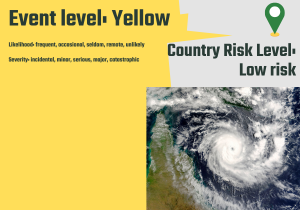
El noroeste de Estados Unidos está enfrentando graves alteraciones en los viajes aéreos debido a un ciclón bomba que está afectando a la región. Las operaciones en el Aeropuerto Internacional de San Francisco (SFO) han sido significativamente impactadas, con más de 40 vuelos cancelados y numerosos retrasos. Esta situación afecta no solo a los viajeros locales, sino también a las conexiones con aeropuertos internacionales y nacionales en todo el país.
La tormenta, caracterizada por fuertes vientos, intensas lluvias y nieve, está dificultando las operaciones en aeropuertos clave del noroeste del Pacífico. Entre los más afectados se encuentran:
– Aeropuerto Internacional de San Francisco (SFO): Numerosos vuelos cancelados y retrasados.
– Aeropuerto Internacional de Portland (PDX): Operaciones ralentizadas debido al mal tiempo.
– Aeropuerto Internacional de Seattle-Tacoma (SEA): Retrasos en vuelos nacionales e internacionales.
La situación está empeorando a medida que el ciclón avanza hacia el sur, extendiendo su impacto a aeropuertos como el de Sacramento (SMF) y San José (SJC).
El Centro de Predicciones Meteorológicas ha informado que las lluvias persistentes continuarán hasta el 22 de noviembre, mientras que una alerta de inundaciones permanece activa en el norte de California hasta el sábado. En algunas áreas, como Santa Rosa, se espera una acumulación de hasta 30 centímetros de lluvia, mientras que en San José y Sacramento las precipitaciones podrían alcanzar entre 2.5 y 5 centímetros.
Además, las cadenas montañosas de las Cascadas y Sierra Nevada recibirán importantes acumulaciones de nieve, lo que dificultará aún más el transporte.
El ciclón bomba actual es el primero de una serie de tres tormentas previstas para la región. La primera tormenta provocó daños significativos en el noroeste del país. La segunda, que afectará entre el 21 y 22 de noviembre, incluye un río atmosférico que intensificará las lluvias y los vientos. Y la tercera tormenta, que tendrá lugar el domingo 24 de noviembre, se espera que afecte principalmente al sur de California, complicando los viajes en áreas metropolitanas como Los Ángeles y San Diego.
Estas condiciones meteorológicas extremas coinciden con el período de viajes por el Día de Acción de Gracias, uno de los más transitados del año, aumentando el riesgo de retrasos y cancelaciones.
– Se recomienda a los viajeros consultar el estado de sus vuelos antes de dirigirse a los aeropuertos.
– El tráfico terrestre en carreteras podría verse afectado por lluvias y nieve.
– Las condiciones en las zonas costeras y montañosas pueden cambiar rápidamente, por lo que se aconseja estar preparados.
– La Oficina Nacional de Administración Oceánica y Atmosférica (NOAA) aconseja mantenerse alejados de árboles durante los fuertes vientos.
– Los viajeros deben mantenerse informados y tomar precauciones adicionales para garantizar su seguridad durante estos fenómenos meteorológicos.
United States. Pacific coast bomb cyclone affects air connections.
The northwestern United States is facing severe disruptions to air travel due to a bomb cyclone that is affecting the region. Operations at San Francisco International Airport (SFO) have been significantly impacted, with more than 40 flights cancelled and numerous delays. This situation affects not only local travellers, but also connections to international and domestic airports across the country.
The storm, characterised by high winds, heavy rain and snow, is hampering operations at key airports in the Pacific Northwest. Among the hardest hit are:
– San Francisco International Airport (SFO): Numerous flights cancelled and delayed.
– Portland International Airport (PDX): Slowed operations due to bad weather.
– Seattle-Tacoma International Airport (SEA): Delays to domestic and international flights.
The situation is worsening as the cyclone moves south, extending its impact to airports such as Sacramento (SMF) and San Jose (SJC).
The Weather Prediction Center has reported that persistent rains will continue through November 22, while a flood warning remains active in Northern California through Saturday. In some areas, such as Santa Rosa, accumulations of up to 30 centimetres of rain are expected, while in San Jose and Sacramento rainfall could reach 2.5 to 5 centimetres.
In addition, the Cascades and Sierra Nevada mountain ranges will receive significant snow accumulations, making transportation even more difficult.
The current bomb cyclone is the first in a series of three storms forecast for the region. The first storm caused significant damage in the northwest of the country. The second, due to hit between 21-22 November, includes an atmospheric river that will intensify rain and winds. And the third storm, on Sunday 24 November, is expected to affect mainly southern California, complicating travel in metropolitan areas such as Los Angeles and San Diego.
These extreme weather conditions coincide with the Thanksgiving travel period, one of the busiest of the year, increasing the risk of delays and cancellations.
– Travellers are advised to check their flight status before heading to airports.
– Road traffic on highways could be affected by rain and snow.
– Conditions in coastal and mountainous areas can change rapidly, so be prepared.
– The National Oceanic and Atmospheric Administration (NOAA) advises staying away from trees during high winds.
– Travellers should stay informed and take extra precautions to ensure their safety during these weather events.
